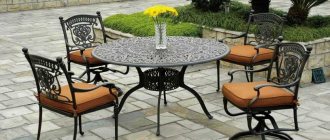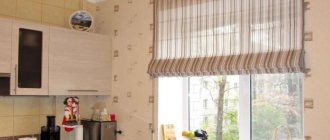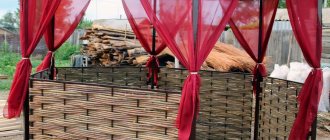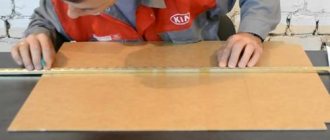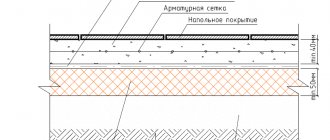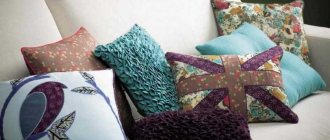How to create an original panel for the kitchen with your own hands?
A comfortable, beautiful kitchen, where it is pleasant to be and even the atmosphere is conducive to work, is the natural desire of every modern housewife. A unique interior design or a recent renovation helps to cope with this problem, but due to the fact that quite a lot of time is spent in the kitchen, it soon gets boring and again you want something unusual and new.
And since making repairs every three to four months is a very difficult and absurd task, you can refresh the room in simpler ways. One of them is to create a kitchen panel with your own hands, which will decorate any interior and give it an attractive look.
This technique is extremely common; most often such decor can be found on the plane of the wall above the stove. This is perhaps the most advantageous place for him. At the same time, you don’t have to go to the store in search of something special - you can create a kitchen panel with your own hands.
Expert opinion
Smirnova Ekaterina Anatolevna
7 years of experience in interior design, professional architect
Moreover, such a decoration will become truly original and unique, and from simple improvised means that every housewife has at her disposal, unique masterpieces are often obtained.
Ceramic kitchen panel
ceramic panel in the kitchen interior
The opportunity to create a unique masterpiece from scrap materials is attractive due to its accessibility and cost-effectiveness. But not all of us have the creative abilities that allow us to develop and implement a creative project. In this case, you should not give up the idea of decorating the interior with exclusive decor. Ceramic tiles in a kitchen panel will be an ideal way to uniquely decorate a room.
The modern range of this material allows you not to limit yourself in the embodiment of creative ideas. Tiles differ in shape, size, shades, texture, which makes it possible to create any decor.
decorating the work area and apron with ceramic panels gives the interior unique features
Using tiles in kitchen backsplashes provides several benefits. This decoration:
- has excellent functional performance;
- successfully complements classical and modern styles;
- may be part of wall decoration.
Most people use tile panels on the backsplash in the kitchen. This zone has increased difficulty. It creates high temperature and humidity, and it is possible that drops of fat, water, and food components may fall onto the surface. The tile adequately withstands such tests. It is easy to clean it from any dirt using detergents.
mosaic panel
The panel on the apron in the kitchen can be made in any style. Country will be decorated with ethnic ornaments, Provence will be successfully complemented by imitation wood and stone, bright gloss will fit perfectly into high-tech, loft will be supported by brickwork, etc.
Ceramic materials are often used in wall decoration. They guarantee the attractiveness of the room and the preservation of aesthetic characteristics for many years. A kitchen wall panel made from this material can be part of the overall design of both the working and dining areas.
Options for creating a kitchen panel
To decorate your kitchen, you don’t have to resort to financial expenses. Handmade work will not only be cheap, but will certainly bring pleasure.
There are a lot of ideas for panels in the kitchen, and implementing them is not difficult at all. In addition, in addition to the usual landscapes and still lifes, you can show your own imagination, experiment a little and get a result that will please not only the housewife, but also all household members.
Panels with paints
Anyone can paint a simple picture, even someone who has absolutely no skills in painting. For example, you can use regular tape to divide the canvas into equal sectors, and then paint each of the resulting parts with bright colors. All you need is a little care and patience in your work, because you need to apply the paints so that they do not overlap each other.
It is also necessary to think in advance how organically such a picture will look. After all, in a Gothic or minimalist style kitchen, a bright, cheerful panel will become an inappropriate spot on the wall. Therefore, it is very important that all colors not only combine with each other, but also that there is harmony with the overall style of the room.
Collage of photos
Relatives and loved ones in the photo always instantly bring a smile and create a great mood. So why not use this to make panels for the kitchen? In addition to photographs, you will need paints, colorful cardboard, tape, scissors and a window frame made of small glasses. The whole process is carried out in four stages:
- First, the size of each photo must be adjusted to the size of the glass;
- then the photo is placed on cardboard of a suitable color and attached to the frame using tape;
- under each photo you can make beautiful signatures with paints;
- The last stage is the decoration of the frame itself.
So simply and quickly, and most importantly, at no cost, you can create an original kitchen wall panel with your own hands.
Main features of the panel
panels for the kitchen should be selected according to the design of the room
The interior can become attractive and individual when it has a zest, a spectacular accent. You can use bright spots and a play of contrasts for this. But these techniques are not always advisable to use in a kitchen environment, where an atmosphere of comfort and warmth is needed. Creative people, lovers of extraordinary solutions, place panels on the kitchen wall.
This solution performs two significant functions. A unique, hand-made panel in the kitchen guarantees its personal character and originality. In addition, it becomes an expressive accent, a kind of center around which the rest of the interior is formed.
panels for the kitchen from plates of different sizes and shapes
There is no need to draw an analogy between a painting, a poster and a panel. These are completely different types of decor. A painting or poster, even those made in 3D format, are flat images. Their attractiveness is undeniable. But the created volumetric panel for the kitchen on the wall has maximum expressiveness and accurately realizes the creative idea. However, there are also non-voluminous options for such decor. But they also have certain features that distinguish them from the traditional picture.
panels as a bright accent in the interior
There are several significant reasons why you should decorate a panel in the kitchen on the wall:
- the interior lacks expressiveness and looks boring;
- there is no way to clearly emphasize a certain style with the help of furniture and decoration;
- there is a desire to reflect your individual characteristics in the design of the kitchen;
- it is necessary to properly mask existing flaws.
Regardless of the reason for which the decision was made to use such decor, it will bring positive changes to the environment.
Let's use buttons
Another unusual option is a kitchen panel made of buttons. To make it, you will need to determine the location in advance and paint the selected part of the wall with water-based paint of the desired shade. After this, the frame should be attached along the edges of the paint using universal glue.
And then we use buttons. In this case, they are used in a way that is not quite standard for them - they are not sewn on, but glued.
You can fill the prepared space in any way: chaotically stick buttons of various colors and sizes, or lay out some pattern with them, as your imagination dictates. The main thing is that all the space in the frame is filled as much as possible, since empty spaces will not look very attractive.
Button panel
When making the next panel, we will use a method unusual for buttons - we will not sew them on, but glue them.
For this we need:
- roller for walls;
- a little water-based paint of a suitable color;
- frame;
- buttons of all shapes, colors and sizes;
- glue (universal).
First, let's paint the wall in the chosen color. Then we will glue a beautiful frame in the place where we planned to place our panel. And finally, the most interesting thing - we will fill the internal space of the frame by gluing buttons in random order (or laying out the intended pattern with them).
Sand panel
You can buy regular sand at any building materials store. It is inexpensive, but allows you to create a real masterpiece. This type of panel in the kitchen will look unusual and can even be an excellent option for an original gift.
Before starting work, the sand must be sifted through a sieve, making it uniform, clean and beautiful. The fabric is stretched onto the frame and the image previously selected for the panel is transferred using a stencil. Then this area of fabric should be coated with glue and covered with sand.
To ensure that the edges of the pattern are as smooth as possible, excess sand is removed with a regular toothpick or any other pointed object. After the glue has dried, you can simply shake off all unnecessary sand and all that remains is to place the decoration in the chosen place.
Other options
One of the most successful materials for creating panels is coffee beans. Most often, burlap is glued onto cardboard, then a cup is outlined and, after covering it with a layer of glue, a pattern of coffee beans is laid out. The frame can be decorated with bows made of thick threads.
The easiest way to make a panel for the kitchen is a piece of foam plastic, wrapped in a beautiful ironed fabric, attached with double-sided tape.
The creation of this type of decor is limited solely by your own imagination. After all, completely different materials can be used for panels. Sometimes even spoons or forks on the wall attract attention and give the kitchen a special originality.
Panel of dried flowers and leaves
You can make a panel with your own hands using various gifts of nature - leaves, cones, dried flowers. A panel of leaves for the kitchen looks cute and elegant, especially if very unusual specimens are used. From dried leaves brought from distant countries, you can create a beautiful collage, especially if you complement them with local dried flowers and pictures. A detailed master class on working with dried flowers can be viewed on the Internet.
A panel of dried roses will look elegant and sophisticated
The main thing here is to work carefully, as the material is very fragile. The composition of leaves must first be assembled separately, to see how harmonious it will look. Then you need to carefully transfer the composition of leaves onto the background base, gluing one element at a time. After finishing the work, the composition of leaves is covered with glass and placed in a frame so that the dried flowers do not collect dust. The kitchen panel is ready!
DIY kitchen panels: 9 original ideas
There is no more functional room in the apartment than the kitchen. Here they cook, receive guests, greet the morning with a cup of coffee and brew tea before bed. It is not always possible to make this room stylish and cozy, since this requires large sums of money. A DIY panel can be a wonderful and inexpensive decoration - this is just the thing for the kitchen.
Determining the scope of work
A panel is a painting made with paints or three-dimensional elements. It has a special use for the kitchen - it can hide repair errors. The best housewife cannot always save her workplace from cracks, grease stains, and drips. If your goal is to hide a problem, then the size of the panel is chosen based on the scale of the problem.
If the task is simply to decorate the room, then the choice depends on the size of the kitchen. A huge painting covering the entire wall will not suit miniature rooms, and one small applique will be lost against the backdrop of a large space. Choose something in between.
A universal option is small paired panels. Moreover, there may be more than two, but always on the same topic. The kitchen is decorated with triptychs - three paintings that continue each other.
Interesting: a panel can not only decorate the kitchen, but also divide it into functional zones. Above the coffee table there are images and photos with mugs, and near the work surfaces there are various fruits and vegetables.
Selecting a topic
In the kitchen, it is important that the details match the design concept. The panel should decorate, stand out, and match the color scheme, style and functionality of the room.
- A modern kitchen is decorated with various vector images with clear lines and metal details.
- Wood textures, photos and art still lifes, panels with dry plants and cereals are suitable for an interior in the Provence style.
- Panels made from aged paper, wine corks and three-dimensional images will organically fit into a loft-style kitchen.
Don't worry if your kitchen doesn't have a specific theme or style: you can set the tone with decorative elements.
Style features
Each decoration must match the style of the interior for which it is intended. Homemade paintings are no exception. Before coming up with any idea, it is necessary to study the characteristics and features of the style, select suitable materials and techniques in which the product will be made. If you are planning any kind of image (graphics, painting, photography, embroidery, etc.), the choice of subject is also important.
Paintings or panels are considered thematic decorations and are designed to create a certain accent in any room, including the kitchen. For interiors in country and Provence style, pictures made using the technique of decoupage, oil painting, watercolor or pastel, as well as embroidery are suitable. As a subject, you can use everyday scenes, landscapes depicting village or city streets, gardens, the sea coast, etc. Still lifes of fruits and vegetables or bouquets of wild flowers will look good.
In minimalism, graphic images, photos or abstractions are appropriate. The picture should be framed by a simple frame without unnecessary decorative elements and details, but you can do without it if the canvas has neat ends. Scandinavian style involves decorating interiors with both ready-made paintings purchased in a store and those made with your own hands. Bright images of geometric shapes or abstraction, letters, and various inscriptions are suitable here. For panels you can use nails, buttons, sequins, wooden planks, stones, buttons, etc. Even a skillfully made empty frame can become a successful interior accent.
Large accessories are suitable for a loft kitchen: panels made from wine corks and old newspapers, graphite boards, retro posters framed, as well as letters backlit with LEDs.
Decorative panels can also play a functional role. For example, a small mirror can be placed inside a painting made from various spices, cereals and grains.
Materials for creating panels
In fact, panels can be created from anything! The main thing here is to take into account the relevance of the plot and not overload the image. It must also be remembered that many materials absorb odors, so compositions made from them should not be placed near stoves.
To create a panel for the kitchen with your own hands, any kitchen utensils (spoons, plates, cups), spices, magazines, photos, scraps of fabric, threads, bottle caps, paper and various little things can be used. The main thing is inspiration and an evening to create a masterpiece.
Panel of prints of fruits and vegetables
Even a child can create this image, and your creation will look simply wonderful.
Will be needed:
- hard fruits or vegetables (apples, pears, citrus fruits, Chinese cabbage);
- paint (oil, acrylic, gouache);
- base (canvas, wooden board, cardboard).
Expert opinion
Smirnova Ekaterina Anatolevna
7 years of experience in interior design, professional architect
Everything is done simply: pour the paint into a plate, cut the fruit into halves, dip it in paint and make a stamp on a previously painted and degreased surface. The color can be matched to the color scheme of the room.
You can make prints anywhere on the canvas, but symmetrical images look better.
Beautiful and functional
If you have wine stoppers or cork lying around at home, create a small board on which you can pin notes, recipes, or photos.
To create a panel from corks you need:
- 20 wine corks;
- scissors;
Cut the corks lengthwise and glue the halves onto the base. If you want to use the other side of the cork, it is important to cut it into equal parts.
Horizontally, vertically, in a pattern - you can lay it out in any way you like, the main thing is to cover the entire base. The panel can be framed, or hung on the wall without a frame. You can attach notes, photos, recipes, pictures and little things to it using pushpins.
Master class: DIY glass paintings for the kitchen
Operating procedure:
- Get a sketch. This could be a printed picture from the Internet or your personal sketch. The size of the sketch should be the same as the size of the glass for the picture.
- Place the piece of paper with the sketch under the glass. Trace the design along the contours onto the glass using a thin brush and black paint or a special stained glass outline. Work your way from top to bottom so you don't smear the outlines or get paint on it.
- After you have transferred all the contours, let the paint dry.
- Now you can start painting the picture. Take brushes and paints and paint each element according to your sketch. It's reminiscent of a child's coloring book, but instead of a sheet of paper you have glass.
- Let the paints dry.
- Secure the result with varnish.
The glass picture is ready! All that remains is to insert it into a frame and hang it on the wall or put it on the kitchen shelf.
New life for old kitchen utensils
You can even make a DIY kitchen panel from unnecessary forks, spoons, scoops and frying pans. The idea can be easily realized with cutlery, base, paints and glue. If you are not sure that the composition will stick well to the glue, then use small nails.
The base for the panel can be anything, but it is important that it can withstand the weight of all the parts that you want to attach to it.
Images and inscriptions with threads
Designers have been actively using the String Art technique for a long time. It does not require any special skills, but you can create a designer panel with threads in an evening.
Required:
- wooden or fiberboard base;
- nails;
- pliers;
- hammer;
- dense acrylic threads;
- pencil.
First, a drawing is applied to the base. You can choose any, but the ideal options for the kitchen are inscriptions, mugs, cups, fruits. You need to choose an image with clear outer lines.
After the design is transferred to the base, nails must be driven along the line at a distance of 0.5 - 2 cm from each other. For convenience and so that all the nails are at the same level, it is better to hold them with pliers.
When the nails are hammered, you need to take a skein of thread and tie the end to one of them. The thread is caught in all places in a certain sequence or in random order. If the pattern is round, it is better to move from one edge to the other. Do not pull the thread too tightly; it may break.
Advice: if you don’t like the color of the base, then apply a layer of paint. You shouldn’t do more than 2-3 layers: when you hammer in nails, cracks will appear.
Preparing panels for the kitchen
Beautiful and voluminous paintings are created from salt dough. It is easy to prepare, dries quickly, paint adheres well to it, and most importantly, you can create anything from it. It is better to coat the finished product with colorless varnish so that it is preserved for a long time. It is important to think in advance about how you will attach the panel to the wall - make a hole or insert a hook.
For the salt dough you need:
Mix everything, add water to achieve the desired consistency. While making the panel, keep the dough in a closed bag and store for up to two days.
The finished mixture replaces ordinary clay. The product is dried in the oven or at room temperature. You can color the finished panel or the dough itself using dye.
Three-dimensional still lifes, various flowers, and fruits are suitable for the kitchen. They are glued to the base or ready-made signs are made from them, as in the photo.
If modeling is not your thing, then create small panels with plant prints. If desired, they are decorated with ribbons and threads.
Glue+base
Traditionally, coffee, pasta and cereals are used in the kitchen to create panels. It's not always cheap and far from original.
If you want to create an unusual panel, and not just a picture of pasta, then use other materials: dried fruits, spices, nuts, buttons, broken dishes, bottle caps. They are laid out in random order or following the selected design/pattern.
The main thing is that the material used is hard and durable, the base is strong, and the glue is quick-drying and reliable.
How to create a kitchen panel using mosaic technique
The most beautiful paintings for the kitchen are made from natural materials. Rhinestones, glass, pieces of broken tiles, shells and cereals, laid out on cardboard and secured with glue, result in amazing patterns, unique and original, emphasizing the style of the kitchen.
Algorithm of actions:
- We select the necessary material. It is important that the mosaic elements are clean and not too large (in our case, pieces of broken tiles are used).
- On a base (thick cardboard or chipboard sheet), pre-treated with glue, a pattern of small tile particles is laid out. It's good if the tiles are multi-colored. For monochromatic fragments, the mosaic is laid out fragmentarily in the form of a specific pattern.
- The finished panel is coated with a protective varnish or inserted into a frame under glass.
Related article: [True or Deception] Are white walls really stainable?
Pallet decorations
Palettes are a popular material for handicrafts today. They make a lot of things: furniture, shelves, walls, gazebos. They are also suitable for kitchen decor.
Important: before decorating the pallets, the surface is thoroughly sanded using a special machine or sandpaper, all elements are degreased and dried.
Expert opinion
Smirnova Ekaterina Anatolevna
7 years of experience in interior design, professional architect
Pallets make original small shelves for plates or photos. They will fit well into the Provence interior and are suitable for apartments and summer country kitchens.
If you insert pots with plants into them, you will get a hanging flower stand. Plants that hang from the structure look ideal.
Pallets are also used as a canvas for drawings - for example, as in this photo.
Soft parts
The kitchen is associated with comfort and warmth, so fabric panels will decorate such a room.
Moreover, even small pieces of material will do. The scraps are cut into equal pieces and sewn together using the patchwork technique. The finished product is stretched onto the canvas or loops are made on top and the finished panel is hung on a wooden stick or miniature cornice.
This is how textile mugs are also sewn, attached to the wall separately or together on one surface.
Compositions from dishes
If you have unnecessary plates lying around at home, then they are suitable for creating an original panel for the kitchen with your own hands.
You will need:
- 3-5 plates;
- paint for ceramics;
- glue;
- printed images.
A common pattern is created on several plates. It is arranged like triptych paintings, where together the canvases create one picture, or 3-4 separate drawings of the same theme.
The image is applied manually or using the decoupage technique. For the latter, you need to print the image in advance on thin paper or buy special sheets for decoupage.
Place the image on pre-degreased and dry plates. Apply PVA glue to the dishes in a thick layer, and tightly place the printed design on top.
Then apply another thin layer of glue on top of the paper.
When everything is dry, cut off the excess and coat the plates with varnish.
Tip: to make the construction of ceramic dishes easier, use disposable paper.
The panel can be made from anything, but for the kitchen it is important that the materials are easy to clean and do not absorb odors. This must be taken into account when choosing those decorations that will be placed near the work surfaces and stove.
What exactly you want to hang in the kitchen depends on your personal preferences, design features and desires.
Types of panels for the kitchen
Original panels on the kitchen wall are made in various ways:
- using tiles;
- from textile materials;
- in the form of a collage of photographs;
- made of tempered glass;
- using decoupage;
- coffee paintings;
- modular options;
- from natural stone;
- from combinations of several materials.
When placing a panel on the wall, it is advisable that the composition is not obscured by other objects
From textiles
The textile artistic canvas is made in the form of appliqué, using the tapestry technique. Common themes include dishes, fruits, flowers. Embroidered versions are also common. The product is usually stretched onto cardboard, plywood, a hoop, a wooden frame, and placed under glass.
Textile paintings made using crochet technique
Strained glass
The glass version of the kitchen panel is very practical for an apron. Using special paints, any images are applied to glass. Less commonly, a picture is made from glass tiles, fragments of various colors and shapes, and pieces of mirrors.
Such decoration can be decorated with hand-made drawings, or represent a photograph with images of landscapes, cities or abstractions
Collage of photos
Photo collages are made up of both black and white and color photos. They are glued to a sheet of fiberboard or thin plywood, decorated with inscriptions, paper stars, hearts, flowers, lace, and inserted into a frame under glass so that they do not deteriorate from moisture.
Framed family photos can be used to decorate an accent wall in the kitchen.
It is recommended to place photo collages so that the sun's rays do not fall on them, due to which the images quickly fade.
Tile
A tiled picture is laid out on the wall, or less often, the floor is decorated. The product is a mosaic consisting of small tiles or larger ones decorated with a photo-printed design. The subject of the image is any, but most often - fruit, floral, abstract options.
Bright panel of colored mosaic on the kitchen apron
A kitchen apron made of multi-colored tiles looks great and is easy to clean.
A panel of tiles protects walls from the negative effects of moisture and high temperature
Coffee paintings
A coffee panel for the kitchen is made by gluing coffee beans onto a rigid base. In addition to coffee beans, pumpkin seeds, lupine, star anise, white and variegated beans, and curly pasta are used. The finished product is varnished and painted. This also includes coffee-themed photo wallpapers.
Using coffee beans, you can create both “flat” paintings and three-dimensional compositions
Decoupage
A painting made up of fragments of decoupage napkins, rice paper, and eggshells can decorate any interior. Gluing is done using PVA glue onto a piece of hardboard, cardboard, or plywood. For durability, the top is coated with spray varnish, having previously painted on individual fragments by hand.
Paintings using the decoupage technique are one of the most common ways to decorate kitchens and other rooms.
Other varieties
Other types of decoration include paintings:
- from pebbles, shells;
- entirely carved from wood;
- from pieces of veneer of different types of wood;
- molded from polymer or ordinary clay, salt dough;
- from beads, beads;
- created from broken glass, ceramic dishes;
- from champagne corks.
Using wine corks cut lengthwise, you can create original patterns and decorate various surfaces
Handmade wooden panel in the format of modular paintings
Painting panel drawing Applique Light panels for the kitchen master class
I would like to bring to your attention three panels for the kitchen. They are very light because they are made from simple cardboard. They are done very easily and simply.
Panel No. 1 (57x20 cm) - “Mom’s Kitchen”))) I discovered the Fix-Price store. There are so many inexpensive cool little things that my imagination tries to use.))) This time I came across decorative wooden pendants for the kitchen - “Mom’s Kitchen” and “Kitchen is the Heart of the Home” (in English)
Take a piece of cardboard. We cover the edges with craft paper with inscriptions (to cover the cardboard sections). This is the back side of the panel in front of you.
On the front side we glue a piece of fabric (with Moment-Crystal glue, only along the edges of the fabric), turning the edges at the top and bottom onto the back side. There I covered the edges of the fabric with paper single-sided tape - for neatness. (See photo 3)
I seal the top edge of the fabric with white lace trim. And I also paste a thin brown ribbon on top of it. The tones are brown, because the panel will be coffee themed.
I decorate the bottom of the panel with a piece of lace. I glue with a thin line or. drops, I don’t use a lot of glue.
I choose a more suitable pendant based on tone.
I glue the pendant at the top, and then, marking it along the ruler, I glue skewers at an equal distance. Each stick has a bow made of jute rope.))) To glue it evenly and tightly, I press down the parts temporarily with some weight.
I use an awl to pierce holes all the way through and use a small screwdriver to thread a silk ribbon through. This will be our hanger. Simple and fast.))) Please note that I don’t throw away the scraps of rope, but use them as decoration under the saucepan.
We hang it vertically, check how it is glued - is it straight?
We lay out the future elements of the panel. Two pieces of burlap and two squares of old white hand knitting (there was once a tablecloth or napkin) will be our basics.
Expert opinion
Smirnova Ekaterina Anatolevna
7 years of experience in interior design, professional architect
Strainer for 25 rubles. from the Fix-Price store was very useful. I sewed it on with thread by hand, as well as a cinnamon stick. Then I glued this entire blank onto the panel.
Coffee beans are glued and framed with toothpicks.
Here are my favorite mini bagels. Everything is covered with acrylic varnish. Although mice also eat with varnish, as I was told.
This is the first panel we came up with. It is convenient because it can be hung on the side of kitchen cabinets.
Panel No. 2. "Coffee Heart"
Here I covered the entire cardboard with a piece of fabric and secured the edges at the back with glue. A brown straw ribbon from a summer hat, again from my favorite store, is glued to the edges in front.))) The heart is a photo frame disassembled into two parts.
Here is the base of a photo frame in the shape of a heart, and I use the frame itself in another coffee panel. Economical and beautiful.))) We used corks cut into pieces.
The third panel (38x25 cm) here everything is done in the same way.. The materials are the same.
Where to start creating a decorative panel for the kitchen
Before you rush to do something, you should try on the size, application and placement, i.e.:
- Location of the craft in the kitchen: on the table, wall or door.
- What material will it be made from?
- Purpose of manufacture: aesthetic value or practical application.
- Choosing the direction and technique of execution.
- Product size.
A panel made by yourself for the kitchen should not get lost in a large space and not stand out too much if the room is small.
Design of panels in the kitchen: options (selection of photos)
A panel is, in fact, a picture in a frame, most often three-dimensional, color or monochrome. They place it in the center of a free wall, build it into a niche, decorate a kitchen apron, even glue it to the ceiling. Paintings highlighted with backlight look original.
The panel will become the main decoration of the kitchen, regardless of its location
It is important to remember that in the kitchen there is always high humidity, food odors, and the likelihood of contamination of any surface is higher than in other rooms. Therefore, “canvases” made using parts of plants, fabrics, paper, wood, are placed at the maximum distance from the cooking site.
The best solution for the cooking area would be a ceramic or glass panel
When choosing a painting, the size of the room is taken into account - the more spacious the kitchen, the larger the panel purchased.
Options for decorative panels for kitchens made of fabric
The easiest thing to make is a patchwork panel. Various pieces of fabric come together for the job. You can find them at home or go to a studio - there are a lot of them left there, they are usually thrown away, so you can get them for free.
To make an abstract craft, you need to cut out various shapes from scraps and sew them together. The joints can be draped with braid. The finished product is placed in a frame and takes its place on the walls in the kitchen.
A felt landscape panel will be a wonderful accent. How to make such a decoration for a room? Very simple. First you need to make a sketch of the future painting. Then cut out the component parts from felt. Each part is glued into place, according to the drawing. After this, the craft is placed in a photo frame.
The panel on the wall emphasizes the style features
11
The choice of style for kitchen decoration largely depends on personal tastes. Some people feel comfortable in cozy country style, others like light Provence, while others appreciate the practicality of minimalism. Regardless of the chosen direction, you need to express it as clearly as possible. Furniture, finishing materials for walls, floors, and ceilings provide significant assistance in solving this problem. But it is not always possible to fully implement the project and emphasize all the advantages of the style.
panel from photo
Photos of kitchen panels allow you to evaluate their ability to easily solve such a problem. The absence of restrictions in the choice of materials and themes provides the opportunity to create a highlight that will tell everything about the advantages of the style and reflect it in all its glory. Moreover, you can create such a masterpiece without resorting to the help of specialists. The Internet offers to evaluate kitchen panels made from wallpaper, fabrics, old dishes, etc. Perfect adherence to the canons of style ensures a smart choice:
- materials;
- shades;
- textures;
- topics.
kitchen panel made in patchwork style
It is not difficult to achieve an exact match. Each design direction has certain specifics that can be reflected in a panel on the wall in the kitchen. It will become the central element of the decor, setting the desired tone.
